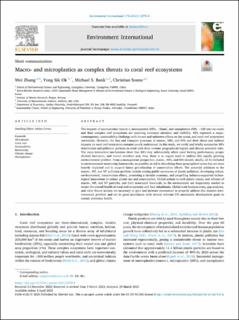| dc.description.abstract | The impacts of macroplastics (macro-), microplastics (MPs, <5mm), and nanoplastics (NPs, <100 nm) on corals and their complex reef ecosystems are receiving increased attention and visibility. MPs represent a major, contemporary, sustainability challenge with known and unknown effects on the ocean, and coral reef ecosystems worldwide. However, the fate and transport processes of macro-, MPs, and NPs and their direct and indirect impacts on coral reef ecosystems remains poorly understood. In this study, we verify and briefly summarize MPs distribution and pollution patterns in coral reefs from various geographical regions and discuss potential risks. The main interaction mechanisms show that MPs may substantially affect coral feeding performance, proper skeletal formation, and overall nutrition and, thus, there is an urgent need to address this rapidly growing environmental problem. From a management perspective, macro-, MPs, and NPs should, ideally, all be included in environmental monitoring frameworks, as possible, to aid in identifying those geographical areas that are most heavily impacted and to support future prioritization of conservation efforts. The potential solutions to the macro-, MP, and NP pollution problem include raising public awareness of plastic pollution, developing robust, environmental, conservation efforts, promoting a circular economy, and propelling industry-supported technological innovations to reduce plastic use and consumption. Global actions to curb plastic inputs, and releases of macro-, MP, and NP particles, and their associated chemicals, to the environment are desperately needed to secure the overall health of coral reef ecosystems and their inhabitants. Global scale horizon scans, gap analyses, and other future actions are necessary to gain and increase momentum to properly address this massive environmental problem and are in good accordance with several relevant UN sustainable development goals to sustain planetary health. | |
